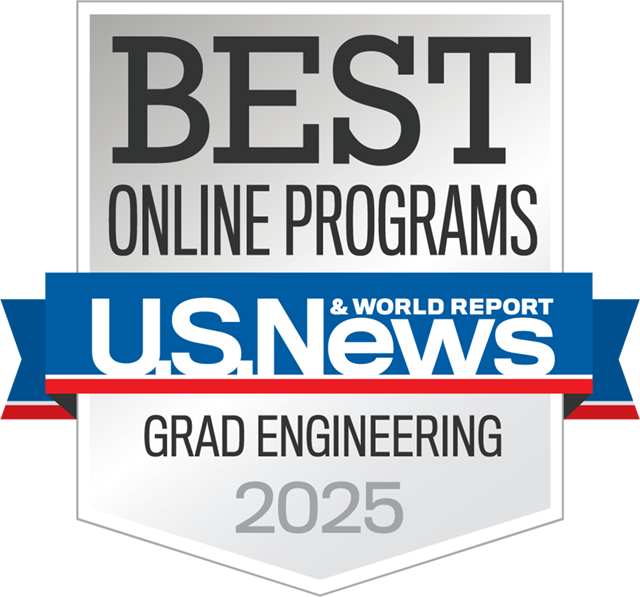100% Online
Complete your Penn State course work at your own pace and 100% online.
Application deadline
Credits and costs
Nationally Recognized

Gain Skills to Excel in the Interdisciplinary Field of Acoustics
Develop your professional identity by selecting core and elective courses that fit your goals.
Learn about acoustical science and engineering applications of acoustics.
Expand your fundamental understanding of sound and vibration.
Advance your ability to develop and apply analysis techniques with applications in acoustics and vibrations.
Customize Your Online Course List
Customize Your Online Course List
Select courses that support your educational and professional goals, choosing from subjects including:
- basic acoustics
- physical acoustics
- signal processing
- ultrasonics
- vibrations
- other emerging topics
A total of 30 course credits are required for the M.Eng. degree, and 18 of those credits must be from 500-level approved core courses in acoustics. The 12 non-core course credits may be selected from the approved list of elective courses offered by the acoustics program or from the approved list of related courses offered by other departments with the approval of the acoustics program.
Prescribed Courses (18 credits)
- 3credits
Vibrational acoustics including mechanical oscillation, forced and damped response, vibration of strings, membranes, rods, bars, and plates.
- 3credits
Thermodynamic and hydrodynamic foundations of linear acoustics in fluids with applications to lumped-elements, reflection, refraction, radiation, attenuation, enclosures, and waveguides.
- 3credits
Time- and frequency-domain analyses for sampled, discrete-time acoustic and vibration measurements.
- 3credits
The theory, design, and calibration of passive, linear, reciprocal electroacoustic transducers for use in both air and water media.
- 3credits
Wave propagation in stationary and moving fluids; acoustic radiation and scattering; standing waves in ducts and cavities.
- 3credits
This course is concerned with the time and frequency-domain analysis of discrete-time signals and discrete-time linear systems, with an emphasis on developing and applying analysis techniques with applications in acoustics and vibrations.
Elective Courses (select 12 credits)
- 3credits
Acoustic radiation from and effects of fluid-loading on vibrating infinite and finite plates and shells. Acoustic transmission through and reflection from elastic plates and shells, acoustic excitation of elastic plates, and coupling between panels and acoustic spaces.
- Prerequisite
ACS 501 and ACS 502
- 3credits
Recent advances in Ultrasonic Nondestructive Evaluation: waves; reflection and refraction; horizontal shear; multi-layer structures; stress; viscoelastic media; testing principles.
- 3credits
The course covers current research in the design analysis and performance prediction for acoustic transducers and acoustical systems that include transducers.
- 3credits
Introduction to the basic and applied aspects of flow-induced noise created by subsonic flows of various complexities.
- Prerequisite
ACS 501 and ACS 502
- 3credits
The course provides an overview of the ongoing research, theory, and practice of outdoor sound propagation, also called atmospheric acoustics.
- 3credits
Introduction to the application of acoustic and vibration fundamentals to the analysis and reduction of noise and vibration problems in industrial and residential settings.
- 3credits
This course will analyze nonlinear acoustics, the study of loud sound waves where linear acoustics is not a good approximation.
- 3credits
This course focuses on the phenomenon of ultrasound in the context of medical and biological applications, systematically discussing physical principles and concepts.
- 3credits
This course provides exposure to the field of computational acoustics including several important computational tools such as symbolic mathematics software, finite differences, finite elements, boundary elements, scientific visualization, and sound propagation algorithms.
- 3credits
This course gives an overview of the recent research in virtual acoustics. These techniques are becoming increasingly more common to provide 3-D sound for home theatre systems, video games, displays for flight simulators, and other virtual reality and immersive environment systems.
- 3credits
This course delves into current research into architectural acoustics. Topics will include research into the human auditory system, reflections, absorption, room modes, room impulse response (RIR) measurements, and room acoustics modeling.
- 3credits
Applications of Aero and Vibro Acoustics compares the natural frequencies of standing waves on strings and in pipes with the scale and intervals used in music.
- 3credits
Ocean acoustics will describe an engineering research approach to measuring and modeling sound propagation, reflection, scattering, and transmission in the ocean and seabed.
- 3credits
This course will present the essential signal processing and acoustical modeling associated with audio systems used in broadcasting, communications, music recording, and video foley production.
- 3credits
Review of fluid mechanics. General theory of aerodynamic sound. Noise radiation from jets, boundary layers, rotors, and fans. Structural response.
Capstone Paper
The Master of Engineering in Acoustics degree does not require a thesis, but it does require a capstone paper, representing a study of a particular topic more limited than what is necessary for a thesis. The paper must involve a topic that is in the public domain, and it does not have to be related to a research project; the primary requirement is that the paper demonstrate application of acoustics content you have learned from the courses taken toward the degree. The paper must be approved by a faculty adviser and the program head. The Distance Education Coordinator in the graduate program in acoustics will help match students with a faculty adviser.
Examples of recent Master of Engineering in Acoustics paper topics:
- Review of Radiated Noise Criteria for Fisheries Research Vessels
- An Overview of Rotorcraft Blade Vortex Interaction (BVI) Noise
- The Effects of Meteorology on the Effectiveness of Noise Barriers
- Vehicle Interior Noise Simulation: The Future State of Noise and Vibration Prototyping
- The Impact of Subsonic Twin Jets on Airport Noise
- Two Applications of Sound Intensity for Industrial Noise Control Engineering
- Fundamentals of Guitar Acoustics
- Computer Modeling for Acoustics with Case Study
- Validation of FEA Damped Model and Optimization on Damping Part Geometry
- Comparison of U.S. Government Roadway Traffic Noise Projection Techniques
- Measuring Voice Coil Fatigue in Micro Loudspeakers
- A System to Record Courtship Songs of the Fruit Fly
Additional course descriptions are available at the College of Engineering's Graduate Program in Acoustics website.
Advance Your Career

Advance Your Career
You can use the knowledge gained from this program and the support of Penn State career resources to pursue careers in industries including audio, biology, medicine, geology, electronics, physics, music, and architecture, as well as in the military.
Job Titles Related to This Degree
Many graduates of the Master of Engineering in Acoustics program are employed in fields such as:
- Acoustic Engineer
- Application Engineer
- Design Engineer
Employment Outlook for Occupational Fields Related to This Degree
Estimates of employment growth and total employment are provided by the U.S. Bureau of Labor Statistics and are subject to change. While these occupations are often pursued by graduates with this degree, individual outcomes may vary depending on a variety of factors. Penn State World Campus cannot guarantee employment in a given occupation.
Engineers, All Other
About Acoustic Engineering Fields
- Architectural acoustics — designing and testing the acoustics of rooms and buildings
- Audio engineering — designing acoustic transducers for audio devices
- Underwater acoustics — underwater sound propagation, signal processing, sonar
- Noise and vibration control — controlling unwanted sound indoors and outdoors
- Engineering acoustics — medical diagnostics, communications, seismic surveying
Career Services to Set You Up for Success

From the day you're accepted as a student, you can access resources and tools provided by Penn State World Campus Career Services to further your career. These resources are beneficial whether you're searching for a job or advancing in an established career.
- Opportunities to connect with employers
- Career counselor/coach support
- Occupation and salary information
- Internships
- Graduate school resources
Ready to Learn More?
Get the resources you need to make informed decisions about your education. Request information on this program and other programs of interest by completing this form.
Ready to take the next step toward your Penn State master's degree?
Costs and Financial Aid
Costs and Financial Aid
Learn about this program's tuition, fees, scholarship opportunities, grants, payment options, and military benefits.
Costs and Financial Aid
Graduate Tuition
Graduate tuition is calculated based on the number of credits for which you register. Tuition is due shortly after each semester begins and rates are assessed every semester of enrollment.
2024–25 Academic Year Rates
| How many credits do you plan to take per semester? | Cost |
|---|---|
| 11 or fewer | $1,027 per credit |
| 12 or more | $12,325 per semester |
2025–26 Academic Year Rates
| How many credits do you plan to take per semester? | Cost |
|---|---|
| 11 or fewer | $1,037 per credit |
| 12 or more | $12,448 per semester |
Financial Aid and Military Benefits
Some students may qualify for financial aid. Take the time to research financial aid, scholarships, and payment options as you prepare to apply. Federal financial aid may only be used to pay for credits used to satisfy program requirements.
Military service members, veterans, and their spouses or dependents should explore these potential military education benefits and financial aid opportunities, as well.
Additional Cost of Attendance Details
To view the detailed list of cost of attendance elements:
- visit the Tuition Information site
- click the plus sign to expand the table
- select a semester from the World Campus row
Technical Requirements
Review the technical requirements for this program.
Set Your Own Pace

Set Your Own Pace
Whether you are looking to finish your program as quickly as possible or balance your studies with your busy life, Penn State World Campus can help you achieve your education goals. Many students take one or two courses per semester.
Our online courses typically follow a 12- to 15-week semester cycle, and there are three semesters per year (spring, summer, and fall). If you plan to take a heavy course load, you should expect your course work to be your primary focus and discuss your schedule with your academic adviser.
To Finish Your Degree in Two and a Half Years
- Take 2 courses each semester
To Finish Your Degree in Three Years
- Take 1 course each semester
Timelines may vary based on course availability.
Convenient Online Format
This program's convenient online format gives you the flexibility you need to study around your busy schedule. You can skip the lengthy commute without sacrificing the quality of your education and prepare yourself for more rewarding career opportunities without leaving your home.
A Trusted Leader in Online Education

Penn State is the only university in the United States to offer a Master of Engineering in Acoustics degree program online. Since 1987, more than 200 students have earned the M.Eng. in Acoustics from Penn State. The program has a global reputation for quality that can lead employers to actively seek out our graduates.
How to Apply to Penn State

How to Apply to Penn State
Apply by August 21 to start August 25
Application Instructions
Deadlines and Important Dates
Complete your application and submit all required materials by the appropriate deadline. Your deadline will depend on the semester you plan to start your courses.
Fall Deadline
Apply by August 21 to start August 25Spring Deadline
Apply now to start January 12
Steps to Apply
For admission to the J. Jeffrey and Ann Marie Fox Graduate School, you must hold either (1) a baccalaureate degree from a regionally accredited U.S. institution or (2) a tertiary (postsecondary) degree that is deemed comparable to a four-year bachelor's degree from a regionally accredited U.S. institution. This degree must be from an officially recognized degree-granting institution in the country in which it operates.
Admission as a Degree Student
Students intending to earn the M.Eng. in Acoustics should hold a bachelor's degree in engineering, physics, mathematics, or a closely related field that would provide substantial preparation in mathematics. All students applying for degree status must have a minimum of four semesters of calculus (Calculus I: derivatives, Calculus II: integrals, Calculus III: multivariable, and Differential Equations) and a minimum of two semesters of calculus-based physics. An undergraduate knowledge of statics and dynamics, linear algebra, and electronic circuit analysis and the ability to use mathematical analysis software is also expected. Students with a 3.00 junior/senior grade-point average (on a 4.00 scale), and with B+ or better average in mathematics, physical science, and engineering courses, will be considered for application.
Students with nontechnical degrees may also apply (provided you meet the minimum math and physics requirements), but acceptance into the program will depend significantly on your undergraduate background and motives to pursue advanced study in acoustics.
Admission as a Nondegree Student
You may enroll in graduate courses in acoustics as a nondegree student-at-large without being admitted into the master’s degree program. However, it is still expected that you have met the minimum math and physics requirements in order to succeed in graduate-level courses in acoustics. You may complete 15 credits (5 acoustics courses) from Penn State as a nondegree student before applying for degree status. Those 15 credits of acoustics courses taken under nondegree status may be transferred into the M.Eng. degree program upon your acceptance as a degree student.
To register as a nondegree student, please visit the College of Engineering's Graduate Program in Acoustics website.
Applications are submitted electronically and include a nonrefundable application fee. If you are applying to the Master of Engineering program as a degree student, you will need to upload the following items as part of your application:
Official transcripts from each institution attended, regardless of the number of credits or semesters completed. Transcripts not in English must be accompanied by a certified translation. If you are a Penn State alum, you do not need to request transcripts for credits earned at Penn State but must list Penn State as part of your academic history.
GPA and Test Scores — All applicants are expected to have earned a junior/senior grade-point average of 3.0 or higher.
GRE or GMAT scores are NOT required for admission but will be considered if provided.
English Proficiency — The language of instruction at Penn State is English. With some exceptions, international applicants must take and submit scores for the Test of English as a Foreign Language (TOEFL) or International English Language Testing System (IELTS). Minimum test scores and exceptions are found in the English Proficiency section on the Fox Graduate School's "Requirements for Graduate Admission" page. Visit the TOEFL website for testing information. Penn State's institutional code is 2660.
References (2) — You will need to initiate the process through the online application by entering names, email addresses, and mailing addresses of two references. Upon submission of your application, an email will be sent to each reference requesting they complete a brief online recommendation regarding your commitment to success in an online program. Please inform all recommenders they must submit the form in order for your application to be complete.
Program-Specific Questions/Materials
Résumé — Upload your résumé to the online application.
Cover Letter — The letter should be addressed to the program chair, stating your current status, general background, degree sought, and an explanation of any deficiencies or requests for consideration.
Statement of Purpose — Provide a one-page summary of your academic goals. (Why do you want to pursue a graduate degree in acoustics? What areas of acoustics are you hoping to pursue? What do you hope to do with your degree afterward?)
To begin the online application, you will need a Penn State account.
Create a New Penn State Account
If you have any problems during this process, contact an admissions counselor at [email protected].
Please note: Former Penn State students may not need to complete the admissions application or create a new Penn State account. Please visit our Returning Students page for instructions.
You can begin your online application at any time. Your progress within the online application system will be saved as you go, allowing you to return at any point as you gather additional information and required materials.
- Choose Enrollment Type: "Degree Admission"
- Choose "WORLD CAMPUS" as the campus
Checking Your Status
You can check the status of your application by using the same login information established for the online application form.5. Complete the application.
Admissions Help
Thank you for your interest in applying to this program. Contact the program to discuss your educational goals, financial aid options, and application deadlines.
Contact Us

Contact Us
Have questions or want more information? We're happy to talk.
For questions about the Master of Engineering in Acoustics degree, our courses and schedules, advising, the differences between degree and non-degree admission, and/or any other questions, please contact:
Kris Popovich
Acoustics Distance Education Manager
Graduate Program in Acoustics
The Pennsylvania State University
201 Applied Science Building
University Park, PA 16802
Phone: 814-863-6078
[email protected]
Dr. Dan Russell
Teaching Professor of Acoustics and Distance Education Coordinator
[email protected]
Learn from the Best
The Master of Engineering in Acoustics program is offered by World Campus in partnership with the Penn State College of Engineering. You will take courses taught by graduate faculty who are active in research and experts in their fields, alongside other master's and doctoral students.


